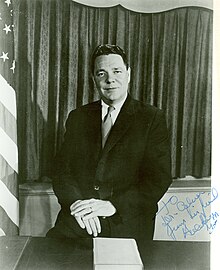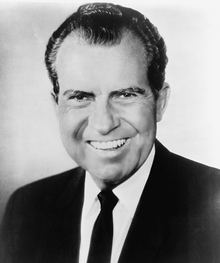User:Nina Studtmann/sandbox
Warning This page contains syntax errors ("cite%20note") caused by a VisualEditor bug. Do not copy/move content from this page until the errors have been repaired. See {{Warning VisualEditor bug}} for more information. |
The Boggs Act of 1951[edit]

The Boggs Act of 1951 amended the Narcotic Drugs Import and Export Act, and established a mandatory minimum sentence for all drug convictions. It was the first act to arrange drug laws into a systematic code, with mandatory minimum sentences for the possession or sale of narcotics. The goal of the Boggs Act was to reduce the extent of the distribution of drugs, with teenagers in particular, and provide strict minimum sentences and fines for violators. “A first offense—even for simple possession without intent to distribute—carried a minimum two- to five-year prison term. A second offense carried prison terms of five to ten years, and a third offense carried a sentence of ten to fifteen years. The act made no distinction between drug users and drug traffickers for purposes of sentencing.”[1] The act did not make a distinction in sentencing between different types of drugs, as carrying marijuana would yield the same penalty as carrying heroine. The act
was sponsored by Hale Boggs, a Louisiana Democrat.[3] On November 2, 1951, Harry S. Truman signed the act into law.[4]
Background[edit]
Leading up to this legislation the public was in great panic about rising drug usage, especially among young people. Statistics from the senate of the Special Committee to Investigate Organized Crime in Interstate Commerce showed fast risings rates of drug usage in the younger population. Representative Hale Boggs (D-LA) observed, “We need only to recall what we have read in the papers this past week to realize that more and more younger people are falling into the clutches of unscrupulous dope peddlers.” [1]
To solve America's growing narcotic drug problem, the Federal Bureau of Narcotics commissioner Harry J. Anslinger proposed the enactment of international drug limitations, the formation of international regulatory bodies (such as the United Nations Commission on Narcotic Drugs), and the passage of national laws which would provide long, mandatory prison sentences and a hospitalization program. Anslinger believed that foreign sources of narcotics were linked to a variety of complex domestic problems. The outcome of Anslinger's proposals included the Uniform State Narcotic Drug Laws, Marijuana Tax Act of 1937, Opium Poppy Act of 1942, Synthetic Substitutes for Morphine Act of 1946, Boggs Act of 1951, and the Narcotics Control Act of 1956. Anslinger cited the rising addiction and violence among juveniles, and he argued that soft-hearted judges were to blame. Anslinger did not believe rehabilitation could effectively solve peoples’ drug problems. Anslinger described drug addicts as incurable, “spread[ing] addiction wherever they are, … contaminat[ing] other persons like persons who have smallpox.” [1]Anslinger believed that increasing public education efforts would encourage, instead of deterring drug use by young people. This was one of the few points Anslinger made during the testimony for the act which drew little consensus from the investigating committee.
Opposition[edit]
In a poll conducted by the Senate Judiciary Subcommittee on Juvenile Delinquency in 1969, 92 percent of federal prison wardens who responded were opposed to the idea of mandatory minimum sentence provisions, and 97 percent were opposed to the prohibition of probation or parole. Of the responding probation officers, 83 percent were opposed to the idea of incorporating a mandatory minimum sentence, and 86 percent were opposed to the bar against probation or parole. Of the federal judges who responded, 73 percent were opposed to a mandatory minimum sentence, and 86 percent were opposed to the absence of probation or parole.[1]
Impacts[edit]
A senate subcommittee led by Senator Price Daniel (D-TX) in 1955 started a project which entailed stopping the selling and trafficking across the country. Data from this project suggested many senators had a lack of knowledge regarding drugs and drug users. When asked by a member of the subcommittee, Anslinger confirmed the “fact” that marijuana users “ha[ve] been responsible for many of our most sadistic, terrible crimes in this Nation, such as sex slayings, sadistic slayings, and matters of that kind.” [1]
On January 4, 1952, under the provisions of the act, nearly 500 suspects were arrested.[2][4] The New York Times reported in their paper on Saturday January 5th of 1952, “A part summary of arrests by localities received at the Treasury Department’s Bureau of Narcotics tonight follows by city and states: Boston, 4; New York, 58; Buffalo, 15; Philadelphia, 50; Trenton, 5; Toledo, Ohio 7; Detroit, 21; Chicago, 40; Kansas City, 6; New Orleans, 22; Seattle, 3; Portland, 4; San Francisco, 24 and District of Columbia, 30. Georgia, 4; Alabama, 3; Florida, 2; Colorado, 2; Kentucky, 20; Tennessee, 7; Texas, 100; California (excluding San Francisco), 15.” Additionally, “Surprises in these figures, Mr. Anslinger said, were those for Philadelphia and Texas.” Later on in the news article, the New York Times reports Mr. Anslinger said, “an unspecified number of military personnel was seized in army camps.”[2]
The federal Boggs Acts were mimicked by "Little Boggs Acts[3]" in the states. Meaning several states governments modified their existing laws to mirror the Boggs Act. This included the Bureau of Narcotics encouraging the states to modify their existing narcotic and marijuana legislation. Ohio and Mississippi particularly strengthened their anti-drug penalties more significantly than any previous jurisdiction.
Repeal[edit]

President Richard Nixon came to office in 1969, and he was determined to address the pervasive drug problem. On July 14, 1969, in a message to Congress, the president called for significant changes to the federal drug control laws: “Within the last decade, the abuse of drugs has grown from essentially a local police problem into a serious national threat to the personal health and safety of millions of Americans. … A new urgency and concerted national policy are needed at the Federal level to begin to cope with this growing menace to the general welfare of the United States”[1]. His ideology was not to just lock drug addicts up, he actually once stated at a governors conference that he believed the best way to counter drugs was through rehabilitation and education.
On July 14, 1969, Attorney General John Mitchell forwarded to Congress the Administration’s proposed bill calling for the reform of the laws governing drug use and abuse. Eventually, the Comprehensive Drug Abuse Prevention and Control Act of 1970 emerged, and heavily changed the governments procedures for handling drugs and drug addicts. It sought to revamp the structure of all criminal penalties for controlled substances to provide a “consistent method of treatment of all persons accused of violations.”[1] Most importantly it eradicated minimum drug sentencing put in place by the Boggs Act.
An individuals first offence of possession of a controlled substance without the intention for distribution would be considered a misdemeanor, and penalties would include fines, as well as probation. Also judges could now expunge minors' records in certain instances. Manufacturing and distributing illegal drugs carried new punishments of up to a maximum of fifteen years’ imprisonment for a first violation, and up to a maximum of thirty years’ imprisonment for subsequent offenses or for adult dealers who sold drugs to minors.[1]
The repeal was commended by the new Congressman George Bush Senior for encouraging "more equitable action by the courts ... and fewer disproportionate sentences.”[1]
Changing political and cultural climate was reflected in more lenient attitudes towards marijuana and drug users as a whole. Use of marijuana became more widespread in the white upper middle class. Reports commissioned by Presidents Kennedy and Johnson around the time of the repeal found that marijuana use did not cause violence nor definitively lead to the use of heavier drugs. Policy towards marijuana began to involve considerations of treatment as well as criminal penalties.
- ^ a b c d e f g h i Gill, Molly (October 2008). "Correcting Course: Lessons from the 1970 Repeal of Mandatory Minimums". University of California Press on behalf of the Vera Institute of Justice. 21: 55–67 – via JSTOR.
- ^ Kennedy, Paul (January 5, 1952). "NEARLY 500 SEIZED IN NARCOTICS RAIDS ACROSS THE NATION". The New York Times. Retrieved May 2, 2019.
- ^ Wallace, Henry (Fall 1993). "Mandatory MiIlimums and the Betrayal of Sentencing Reform: A Legislative Dr. Jekyll and Mr. Hyde" (PDF). Correctional Philosophy and Practice. 57: 9 – via National Criminal Justice Reference Service (NCJRS).
{{cite journal}}: line feed character in|title=at position 37 (help)

